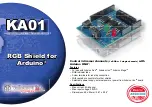Addendum List for Revision 7.1
MPC5607B Reference Manual Errata, Rev. 1
Freescale Semiconductor
5
Chapter 16, Enhanced Direct
Memory Access (eDMA),
page 330 (cont.)
16.5.8.2.2
Method 2 (channel using major loop linking)
For a channel using major loop channel linking, the coherency model in
Table 16-26
may be used for a dynamic scatter/gather request. This method
uses the TCD.dlast_sga field as a TCD identification (ID).
For a channel using major loop channel linking, the coherency model in
Table 16-26
may be used for a dynamic scatter/gather request. This method
uses the TCD.dlast_sga field as a TCD identification (ID).
Table 1. MPC5607BRM Rev 7.1 Addenda (continued)
Location
Description
Table 16-25. Coherency model for method 1
Step
Action
1
When the descriptors are built, write a unique TCD ID in the TCD.major.linkch field for
each TCD associated with a channel using dynamic scatter/gather.
2
Write 1b to theTCD.d_req bit.
Note: Should a dynamic scatter/gather attempt fail, setting the d_req bit will prevent a
future hardware activation of this channel. This stops the channel from
executing with a destination address (daddr) that was calculated using a
scatter/gather address (written in the next step) instead of a dlast final offset
value.
3
Write theTCD.dlast_sga field with the scatter/gather address.
4
Write 1b to the TCD.e_sg bit.
5
Read back the 16 bit TCD control/status field.
6
Test the TCD.e_sg request status and TCD.major.linkch value:
• If e_sg = 1b, the dynamic link attempt was successful.
• If e_sg = 0b and the major.linkch (ID) did not change, the attempted dynamic link
did not succeed (the channel was already retiring).
• If e_sg = 0b and the major.linkch (ID) changed, the dynamic link attempt was
successful (the new TCD’s e_sg value cleared the e_sg bit).


















